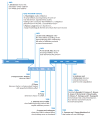Mechanisms of inhibition within the telencephalon: "where the wild things are"
- PMID: 21469958
- PMCID: PMC3556485
- DOI: 10.1146/annurev-neuro-061010-113717
Mechanisms of inhibition within the telencephalon: "where the wild things are"
Abstract
In this review, we first provide a historical perspective of inhibitory signaling from the discovery of inhibition through to our present understanding of the diversity and mechanisms by which GABAergic interneuron populations function in different parts of the telencephalon. This is followed by a summary of the mechanisms of inhibition in the CNS. With this as a starting point, we provide an overview describing the variations in the subtypes and origins of inhibitory interneurons within the pallial and subpallial divisions of the telencephalon, with a focus on the hippocampus, somatosensory, paleo/piriform cortex, striatum, and various amygdala nuclei. Strikingly, we observe that marked variations exist in the origin and numerical balance between GABAergic interneurons and the principal cell populations in distinct regions of the telencephalon. Finally we speculate regarding the attractiveness and challenges of establishing a unifying nomenclature to describe inhibitory neuron diversity throughout the telencephalon.
Figures



References
-
- Alger BE, Nicoll RA. GABA-mediated biphasic inhibitory responses in hippocampus. Nature. 1979;281:315–17. - PubMed
-
- Alvarez-Leefmans FJ. Intracellular Cl− regulation and synaptic inhibition in vertebrate and invertebrate neurons. In: Alvarez-Leefmans FJ, Russell JM, editors. Chloride Channels and Carriers in Nerve, Muscle and Glial Cells. New York: Plenum; 1990. pp. 109–58.
-
- Alvarez-Leefmans FJ, Delpire E. Thermodynamics and kinetics of chloride transport in neurons: an outline. In: Alvarez-Leefmans FJ, Delpire E, editors. Physiology and Pathology of Chloride Transporters and Channels in the Nervous System. New York: Academic; 2009. pp. 81–108.
-
- Aoki C, Pickel VM. Neuropeptide Y in cortex and striatum. Ultrastructural distribution and coexistence with classical neurotransmitters and neuropeptides. Ann NY Acad Sci. 1990;611:186–205. - PubMed
Publication types
MeSH terms
Substances
Grants and funding
- 2R01MH071679-09/MH/NIMH NIH HHS/United States
- R01 MH071679/MH/NIMH NIH HHS/United States
- R01 NS032993/NS/NINDS NIH HHS/United States
- 5R01NS039007-1/NS/NINDS NIH HHS/United States
- R37 MH071679/MH/NIMH NIH HHS/United States
- R01 NS081297/NS/NINDS NIH HHS/United States
- R01 NS039007/NS/NINDS NIH HHS/United States
- 5R01MH068469-08/MH/NIMH NIH HHS/United States
- 5R01NS045217-08/NS/NINDS NIH HHS/United States
- R01 MH068469/MH/NIMH NIH HHS/United States
- 2R01NS030989-18/NS/NINDS NIH HHS/United States
- R01 NS030989/NS/NINDS NIH HHS/United States
- R01 NS045217/NS/NINDS NIH HHS/United States
- 3R01NS045217-06A1S1/NS/NINDS NIH HHS/United States
LinkOut - more resources
Full Text Sources
Other Literature Sources

